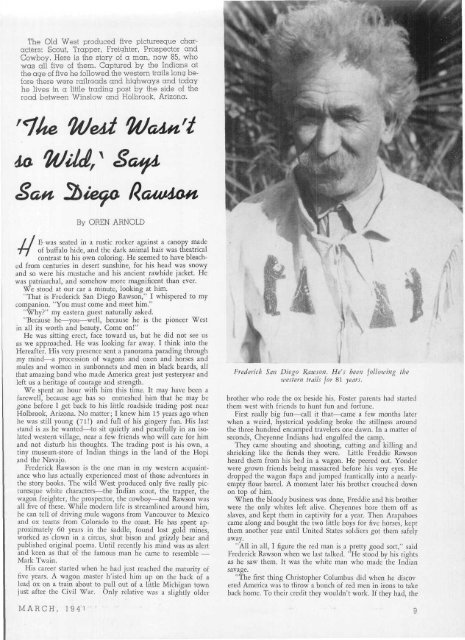194103-DesertMagazin.. - Desert Magazine of the Southwest
194103-DesertMagazin.. - Desert Magazine of the Southwest
194103-DesertMagazin.. - Desert Magazine of the Southwest
You also want an ePaper? Increase the reach of your titles
YUMPU automatically turns print PDFs into web optimized ePapers that Google loves.
The Old West produced five picturesque characters:<br />
Scout, Trapper, Freighter, Prospector and<br />
Cowboy. Here is <strong>the</strong> story <strong>of</strong> a man, now 85, who<br />
was all five <strong>of</strong> <strong>the</strong>m. Captured by <strong>the</strong> Indians at<br />
<strong>the</strong> age <strong>of</strong> five he followed <strong>the</strong> western trails long before<br />
<strong>the</strong>re were railroads and highways and today<br />
he lives in a little trading post by <strong>the</strong> side <strong>of</strong> <strong>the</strong><br />
road between Winslow and Holbrook, Arizona.<br />
"1U Wed Waist't<br />
tot.<br />
Baa,<br />
By OREN ARNOLD<br />
/ / E- was seated in a rustic rocker against a canopy made<br />
r j~j <strong>of</strong> buffalo hide, and <strong>the</strong> dark animal hair was <strong>the</strong>atrical<br />
contrast to his own coloring. He seemed to have bleached<br />
from centuries in desert sunshine, for his head was snowy<br />
and so were his mustache and his ancient rawhide jacket. He<br />
was patriarchal, and somehow more magnificent than ever.<br />
We stood at our car a minute, looking at him.<br />
"That is Frederick San Diego Rawson," I whispered to my<br />
companion. "You must come and meet him."<br />
"Why?" my eastern guest naturally asked.<br />
"Because he—you—well, because he is <strong>the</strong> pioneer West<br />
in all its worth and beauty. Come on!"<br />
He was sitting erect, face toward us, but he did not see us<br />
as we approached. He was looking far away. I think into <strong>the</strong><br />
Hereafter. His very presence sent a panorama parading through<br />
my mind—a procession <strong>of</strong> wagons and oxen and horses and<br />
mules and women in sunbonnets and men in black beards, all<br />
that amazing band who made America great just yesteryear and<br />
left us a heritage <strong>of</strong> courage and strength.<br />
We spent an hour with him this time. It may have been a<br />
farewell, because age has so enmeshed him that he may be<br />
gone before I get back to his little roadside trading post near<br />
Holbrook, Arizona. No matter; I knew him 15 years ago when<br />
he was still young (71!) and full <strong>of</strong> his gingery fun. His last<br />
stand is as he wanted—to sit quietly and peacefully in an isolated<br />
western village, near a few friends who will care for him<br />
and not disturb his thoughts. The trading post is his own, a<br />
tiny museum-store <strong>of</strong> Indian things in <strong>the</strong> land <strong>of</strong> <strong>the</strong> Hopi<br />
and <strong>the</strong> Navajo.<br />
Frederick Rawson is <strong>the</strong> one man in my western acquaintance<br />
who has actually experienced most <strong>of</strong> those adventures in<br />
<strong>the</strong> story books. The wild West produced only five really picturesque<br />
white characters—<strong>the</strong> Indian scout, <strong>the</strong> trapper, <strong>the</strong><br />
wagon freighter, <strong>the</strong> prospector, <strong>the</strong> cowboy—and Rawson was<br />
all five <strong>of</strong> <strong>the</strong>se. While modern life is streamlined around him,<br />
he can tell <strong>of</strong> driving mule wagons from Vancouver to Mexico<br />
and ox teams from Colorado to <strong>the</strong> coast. He has spent approximately<br />
60 years in <strong>the</strong> saddle, found lost gold mines,<br />
worked as clown in a circus, shot bison and grizzly bear and<br />
published original poems. Until recently his mind was as alert<br />
and keen as that <strong>of</strong> <strong>the</strong> famous man he came to resemble —<br />
Mark Twain.<br />
His career started when he had just reached <strong>the</strong> maturity <strong>of</strong><br />
five years. A wagon master h'isted him up on <strong>the</strong> back <strong>of</strong> a<br />
lead ox on a train about to pull out <strong>of</strong> a little Michigan town<br />
just after <strong>the</strong> Civil War. Only relative was a slightly older<br />
MARCH, 194 1<br />
Frederick San Diego Rawson. He's been following <strong>the</strong><br />
western trails for 81 years.<br />
bro<strong>the</strong>r who rode <strong>the</strong> ox beside his. Foster parents had started<br />
<strong>the</strong>m west with friends to hunt fun and fortune.<br />
First really big fun—call it that—came a few months later<br />
when a weird, hysterical yodeling broke <strong>the</strong> stillness around<br />
<strong>the</strong> three hundred encamped travelers one dawn. In a matter <strong>of</strong><br />
seconds, Cheyenne Indians had engulfed <strong>the</strong> camp.<br />
They came shouting and shooting, cutting and killing anJ<br />
shrieking like <strong>the</strong> fiends <strong>the</strong>y were. Little Freddie Rawson<br />
heard <strong>the</strong>m from his bed in a wagon. He peered out. Yonder<br />
were grown friends being massacred before his very eyes. He<br />
dropped <strong>the</strong> wagon flaps and jumped frantically into a nearlyempty<br />
flour barrel. A moment later his bro<strong>the</strong>r crouched down<br />
on top <strong>of</strong> him.<br />
When <strong>the</strong> bloody business was done, Freddie and his bro<strong>the</strong>r<br />
were <strong>the</strong> only whites left alive. Cheyennes bore <strong>the</strong>m <strong>of</strong>f as<br />
slaves, and Kept <strong>the</strong>m in captivity for a year. Then Arapahoes<br />
came along and bought <strong>the</strong> two little boys for five horses, kept<br />
<strong>the</strong>m ano<strong>the</strong>r year until United States soldiers got <strong>the</strong>m safely<br />
away.<br />
"All in all, I figure <strong>the</strong> red man is a pretty good sort," said<br />
Frederick Rawson when we last talked. "He stood by his rights<br />
as he saw <strong>the</strong>m. It was <strong>the</strong> white man who made <strong>the</strong> Indian<br />
savage.<br />
"The first thing Christopher Columbus did when he discov<br />
ered America was to throw a bunch <strong>of</strong> red men in irons to take<br />
back home. To <strong>the</strong>ir credit <strong>the</strong>y wouldn't work. If <strong>the</strong>y had, <strong>the</strong>

















